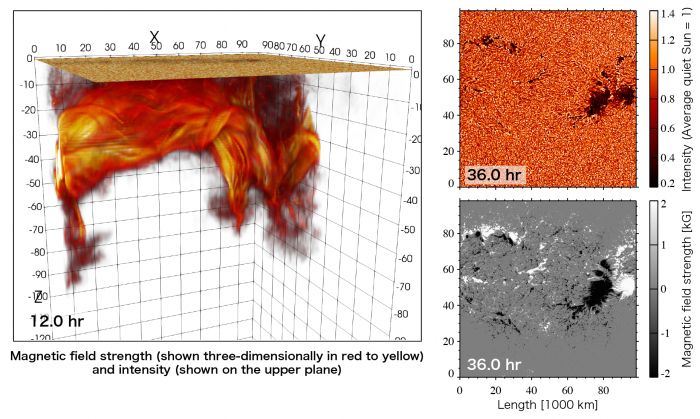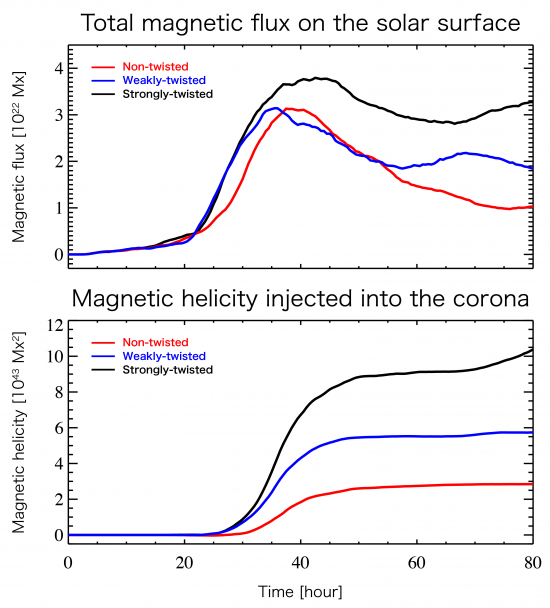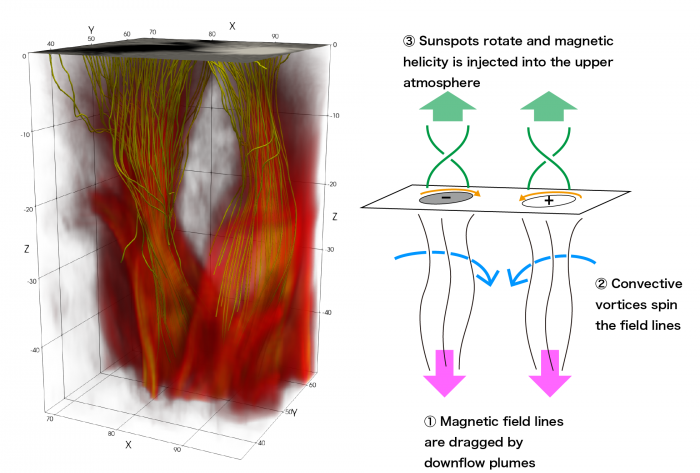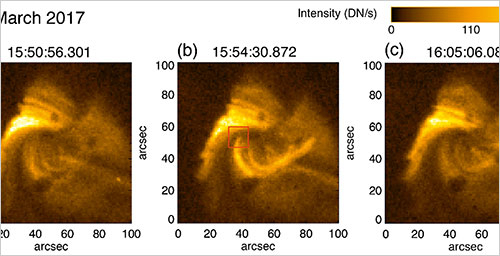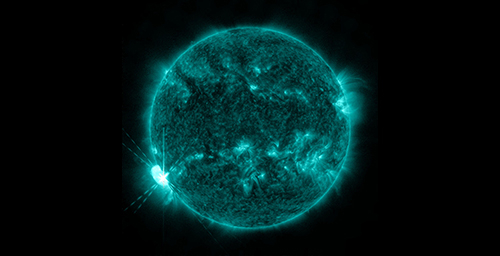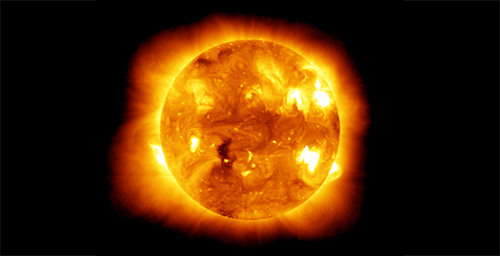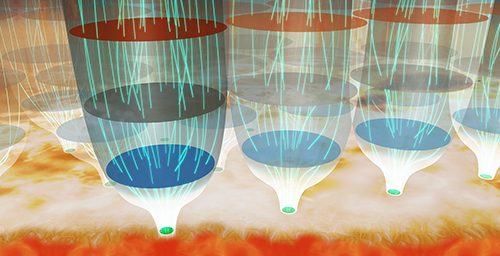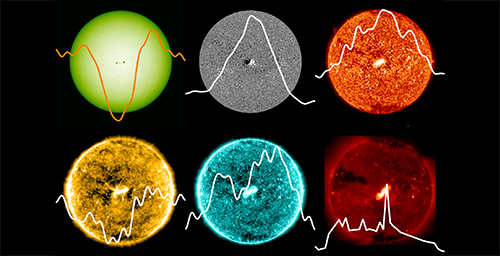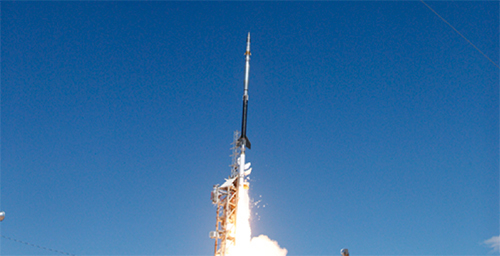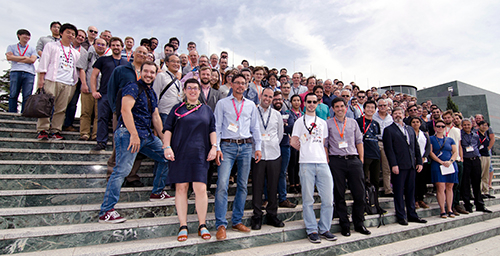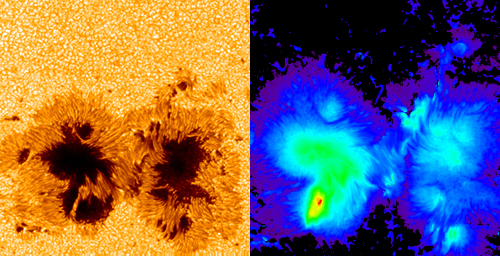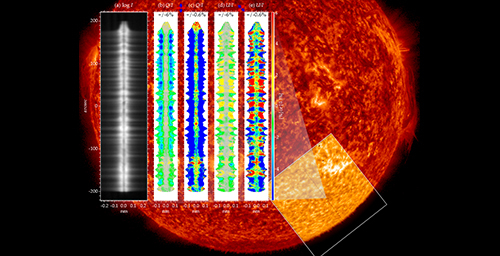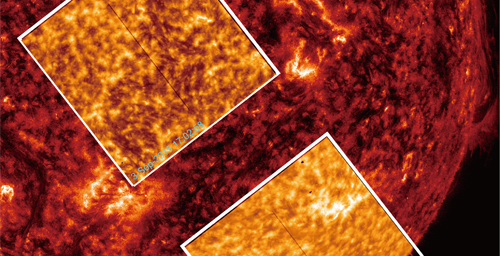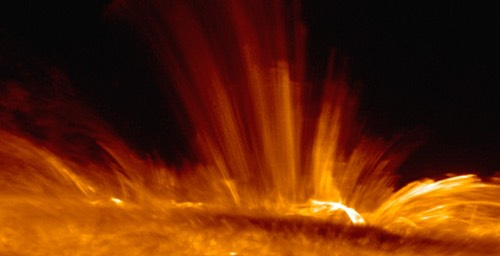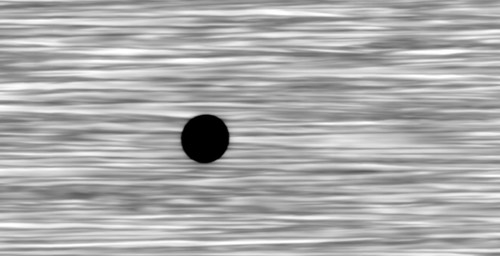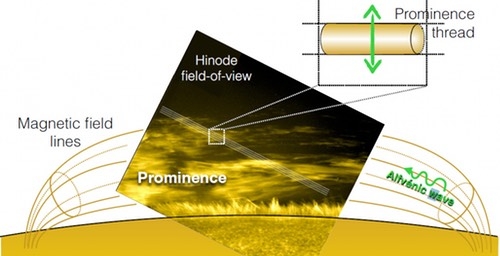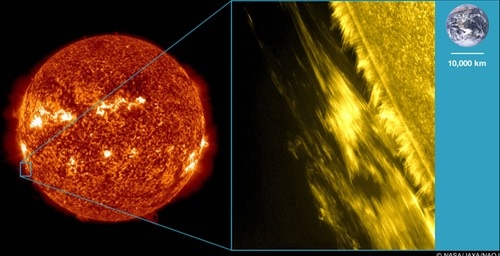Overview
- The massive explosive phenomena that are solar flares are caused by the accumulation of the twisting of the solar magnetic field (magnetic helicity), but it has previously been unclear what controls this twisting. Indeed, it was presumed that bundles of twist-free magnetic flux in the solar interior would not produce a solar flare.
- The interior of the Sun remains invisible to telescopes, but activity can be probed using supercomputer simulations. The research team consisting of Assoc. Prof. Toriumi Shin (JAXA), Prof. Hotta Hideyuki, and Prof. Kusano Kanya (Nagoya University) used this technique to discover that thermal convection in the solar interior has a much greater impact than previously thought on the process that provides the magnetic helicity.
- The team performed large-scale numerical simulations using the supercomputers "Fugaku" (RIKEN) and "ATERUI II" (National Astronomical Observatory of Japan) to reproduce the emergence of bundles of magnetic flux (magnetic flux tubes) from the deep solar interior and their formation of sunspots. By artificially changing the strength of the twist of the flux tubes, the team investigated the differences in the process of injecting magnetic helicity into the solar corona as the magnetic flux emerges and produces sunspots.
- The results of this revealed that even for the case with no magnetic twist, the sunspots rotated because the surrounding convection spins the magnetic flux, and magnetic helicity was injected into the solar corona. The amount of helicity supplied by the thermal convection reached a level that could cause lower-level solar flares.
- The results of this study indicate the possibility that not only the twist of the flux tubes but also the effect of thermal convection in spinning the magnetic flux may play a critical role in providing magnetic helicity and storing the energy required for solar flares, which is an achievement that updates the previous understanding.
- The results were published from Scientific Reports, a Nature portfolio journal.
Main text
Solar flares (Note 1), the largest explosive phenomena in the Solar System, are caused by the sudden release of energy that has been stored by the magnetic field in the solar corona "twisting". Solar flares are prone to occur in and around sunspots, which are a conglomerate of strong magnetic fields, and such processes have been studied in detail through multi-wavelength observations by the Hinode satellite and other observatories. Sunspots are formed as bundles of magnetic flux (magnetic flux tubes) emerge from the solar interior (convection zone). From this, it is thought that solar flares are caused by the emergence of strongly twisted flux tubes from the convection zone and the injection of their twists into the corona when sunspots are formed.
However, since we cannot see through the solar interior, it is not clear how magnetic flux tubes actually emerge and build up sunspots. Specifically, the convection zone is a realm where intense thermal convection occurs, but how the thermal convection affects the magnetic flux remains unclear. Therefore, in this study, the research team performed massive numerical simulations using two supercomputers, "Fugaku" (RIKEN: Note 2) and "ATERUI II" (National Astronomical Observatory of Japan: Note 3), to reproduce the magnetic flux emergence from the convection zone and the formation of sunspots. By artificially changing the twist strength of the flux tubes, the team investigated the effects of thermal convection on flux emergence and sunspot formation.
Figure 1: A non-twisted flux tube rises through the convection zone and builds up sunspots in the solar surface. (Left) Magnetic field strength and intensity in the solar surface at 12 hours after the start of the simulation, (top right) intensity after 36 hours, and (bottom right) magnetic field strength. Sunspots with positive (white) and negative (black) polarities are formed. (Credit: Toriumi et al. (2023))
Figure 1 (left) shows a 3D view of a magnetic flux tube rising through the convective zone. At the beginning of the simulation, a non-twisted (i.e., twist-free) flux tube, placed at about 20,000 kilometers below the solar surface, was levitated by the convective upflow and formed sunspots when it reached the surface. Figure 1 (right) shows the sunspots on the solar surface (top right: intensity; bottom right: magnetic field strength). It is seen that the two sunspots appear, one with the positive polarity (white) and the other with the negative polarity (black).
It has been believed that the flux tubes have to be twisted to some extent in order to overcome thermal convection in the interior and successfully reach the solar surface. However, the present large-scale simulations have revealed that the flux tubes, even without twists, can reach the surface and form sunspots if they are pushed up by upflows.
Figure 2: Temporal evolutions of total magnetic flux on the solar surface (top) and magnetic helicity injected into the corona (bottom). The figures compare the three cases with different initial conditions: Non-twisted (red), weakly-twisted (blue), and strongly-twisted (black) flux tubes. It can be seen that even for the non-twisted flux tube, a finite (i.e., non-zero) magnetic helicity was injected, amounting to a few 10% of that for the cases with twists. (Credit: Toriumi et al. (2023))
Figure 2 shows the temporal evolution when the flux tube emerges and develops sunspots. Figure 2 (top) presents the total magnetic flux on the solar surface (related to sunspot size). Here, three cases are shown for a purpose of comparison of different initial conditions: the non-twisted, weakly-twisted, and strongly-twisted flux tubes. The amounts of twist given to the two twisted cases are comparable to those observed in flare-productive sunspots. From this figure, it is seen that there is no significant difference in the amount of magnetic flux appearing on the solar surface, indicating that sunspots of similar sizes were produced in the three cases.
Figure 2 (bottom) shows the time variation of "magnetic helicity" (an amount indicating the degree of twist in the magnetic field) injected from the solar surface through magnetic field lines extending upward from the sunspots. From the observations of flares, it is known that sunspots with larger magnetic helicity tend to produce stronger flares. From this figure, it is seen that the injection of magnetic helicity occurs not only for the twisted flux tubes but also for the non-twisted case. This is a very interesting result, because it means that the flux tubes that was not initially given a twist possessed a finite (non-zero) magnetic twist when it reached the solar surface. Moreover, the amount of magnetic helicity was from 20% to 50% of those of the twisted cases.
Then, where does this magnetic twist come from? Figure 3 (left) is an enlarged view of the area just below the sunspots for the non-twisted case. The magnetic field lines extend from the sunspots downward in a shape of pillars. Figure 3 (right) presents an illustration of the results of detailed analysis, which shows that the magnetic field lines extending downward from the sunspots are spun by vortices of thermal convection. That is, although the initial magnetic flux tube was endowed with no twist, it gained the twist (magnetic helicity) by the effect of thermal convection during emergence and sunspot formation. Thus, the sunspots on the solar surface rotated in the same directions as the vortices, which in turn injected magnetic helicity into the corona above.
Figure 3: (Left) 3D view of subsurface regions below the two rotating sunspots for the case of non-twisted flux tube. Yellow lines are magnetic field lines, while reddish volume rendering represents magnetic field strength. (Right) Illustration explaining the mechanism of sunspot rotation and magnetic helicity injection. (Credit: Toriumi et al. (2023))
The direction of vortices is considered to be determined at random. This is because the thermal convection inside the Sun is in a state of "turbulence," in which the speed and direction of the flow varies irregularly. In the present simulation, the direction of the vortices happened to enhance magnetic helicity, but in another simulation with different thermal convection, magnetic helicity could be reduced.
Furthermore, the analysis of sunspot magnetic fields created by the non-twisted flux tube revealed that they are capable of causing lower-level solar flares. Since the solar flares are caused by the release of energy stored in the twisting of the magnetic field (magnetic helicity), this result suggests that the effect of thermal convection alone could provide enough magnetic helicity to explain solar flares.
The mechanism of flare occurrence that has been previously widely accepted by the researchers is,
- A twisted flux tube emerges from the convection zone and, as a result, generated sunspots show rotational motions;
- Thus, the twisting of magnetic field (magnetic helicity) is injected into the corona; and
- A solar flare occurs as the energy of magnetic field, stored as magnetic helicity, is suddenly released.
However, the results of this study show that even a flux tube with zero twist can develop sunspots producing flares, because a large amount of magnetic helicity is injected by the effect of thermal convection spinning the magnetic fields. Therefore, this result is a breakthrough in the conventional understanding of the mechanism of flare generation.
The mechanism of flare generation is one of the most important issues in solar physics, and, thus, is a primary observation target of Japan's "Hinode" satellite and even the next-generation solar-observing satellite "SOLAR-C" (Note 4). On the other hand, magnetic flux emergence, sunspot formation, and magnetic helicity injection continue to contain many unresolved mysteries, because we cannot see through the solar interior. Further research using numerical simulations as well as helioseismology (Note 5), a means of probing the solar interior, is expected to clarify how the magnetic field and thermal convection are involved in sunspot formation and flare generation.
Glossary of terms
1. Solar flares: A phenomenon in which the magnetic energy stored in the solar corona is suddenly released. The intensity of electromagnetic waves in various wavelength bands increases for a few 10 minutes to hours, accompanied by coronal mass ejections and emission of energetic particles.
2. Fugaku: RIKEN's supercomputer, launched in March 2021 and having a computation speed of more than 400 PetaFLOPS. Peta is 10 to the power of 15, and FLOPS is a unit for measuring the number of operations a computer can process in one second.
3. ATERUI II: The supercomputer dedicated to astronomy operated by the National Astronomical Observatory of Japan. With a theoretical computing performance of 3.087 PetaFLOPS, it is the world's fastest computer dedicated to numerical simulations of astronomy.
4. SOLAR-C: The next-generation solar-observing satellite, the successor of "Hinode." Its on-board instrument, a high-sensitivity ultraviolet spectroscopic telescope EUVST, will probe the mechanism of solar flares and the mysteries of atmospheric heating. It is being studied and developed through international cooperation between Japan, U.S., and European partners, with the aim of launching it in Japanese fiscal year 2028.
5. Helioseismology: A method of probing the structure of the solar interior by observing the oscillation of the solar surface. It is the only means of probing the solar interior, which cannot be seen through, and is expected to elucidate the thermal convection and magnetic fields.
Publication information
Paper title: Turbulent convection as a significant hidden provider of magnetic helicity in solar eruptions
Journal title, volume, paper id: Scientific Reports, 13, 8994
Publication date: June 2nd, 2023
DOI: 10.1038/s41598-023-36188-z
URL (open access): https://doi.org/10.1038/s41598-023-36188-z
Authors and affiliations:
Toriumi Shin, Institute of Space and Astronautical Science, Japan Aerospace Exploration Agency
Hotta Hideyuki, Institute for Space-Earth Environmental Research, Nagoya University (Graduate School of Science, Chiba University at the time of paper writing)
Kusano Kanya, Institute for Space-Earth Environmental Research, Nagoya University
Research support
This work was supported by the following grants.
- JSPS KAKENHI (Grant Nos. JP20KK0072, JP20K14510, JP21H01124, JP21H04492, JP21H04497, JP23H01210)
- MEXT Program for Promoting Researches on the Supercomputer Fugaku (Grant Nos. JPMXP1020230504, JPMXP1020230406)
Numerical simulations were performed using RIKEN "Fugaku" (No. hp210164) and NAOJ "ATERUI II".

